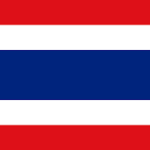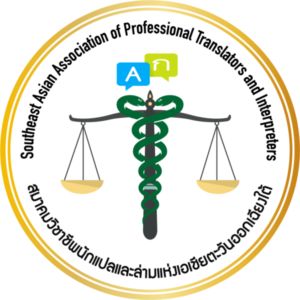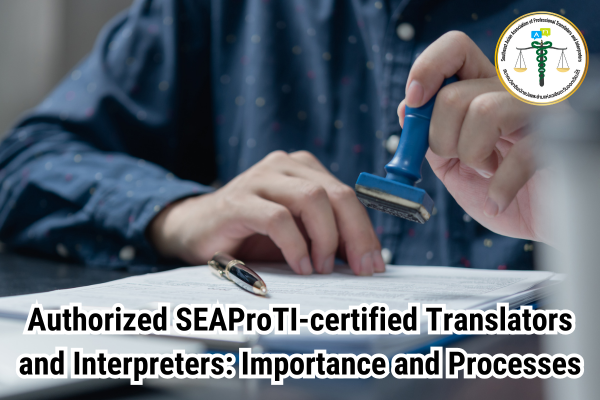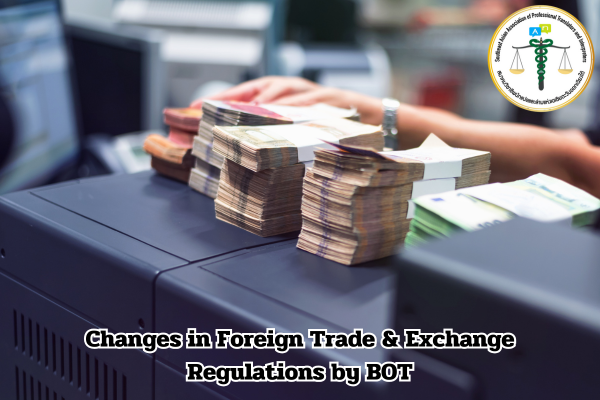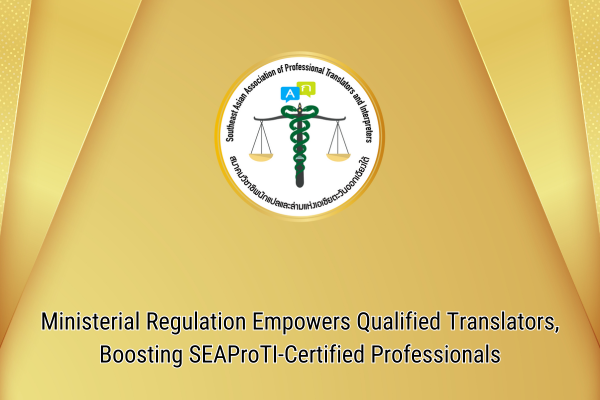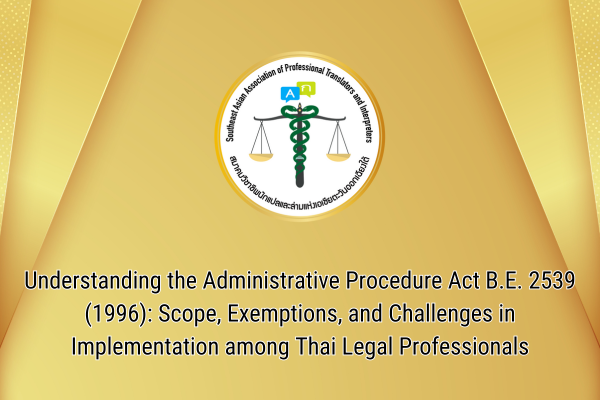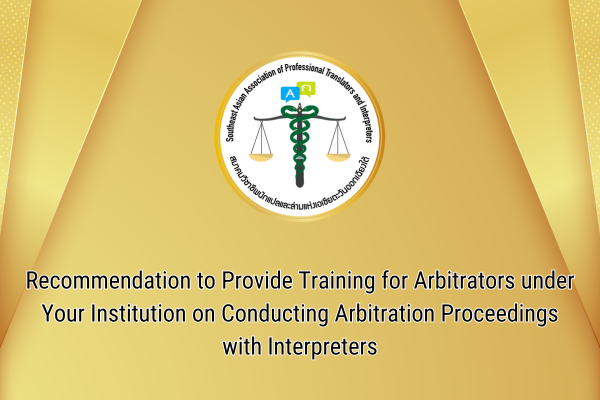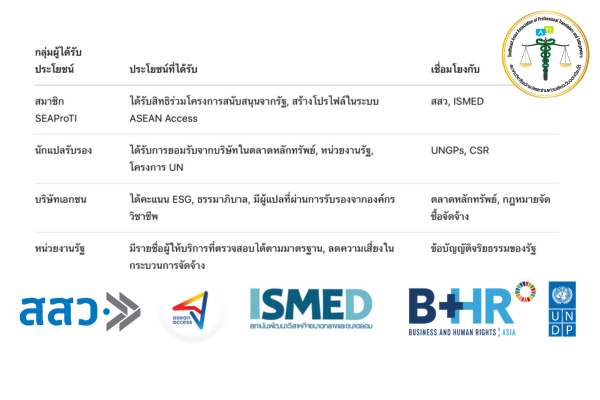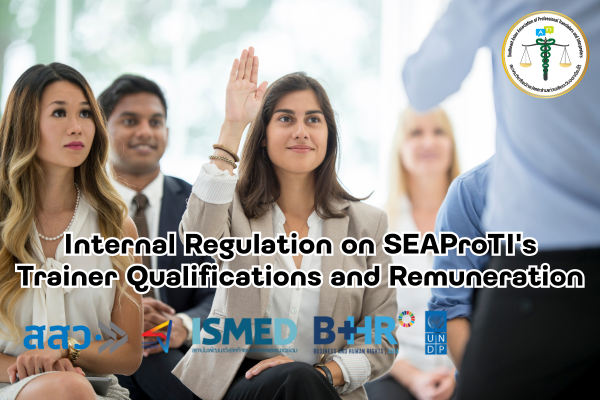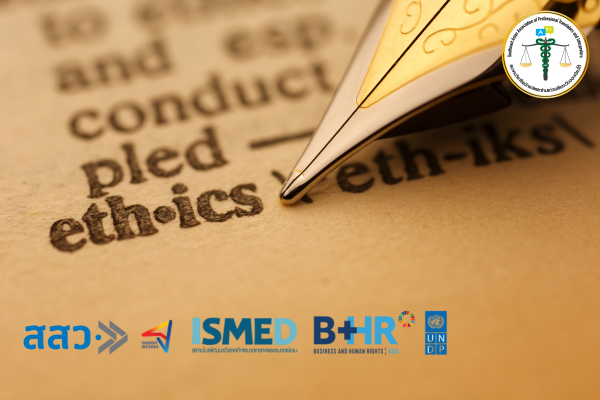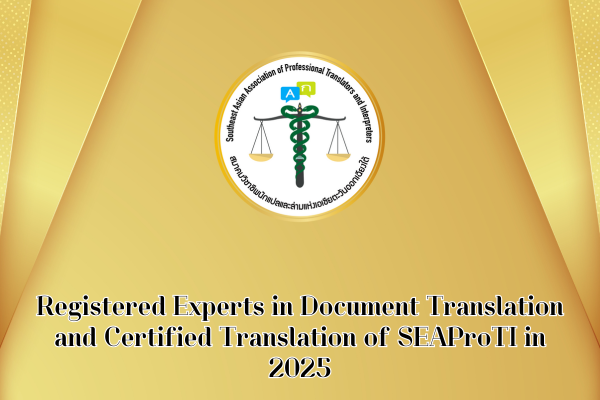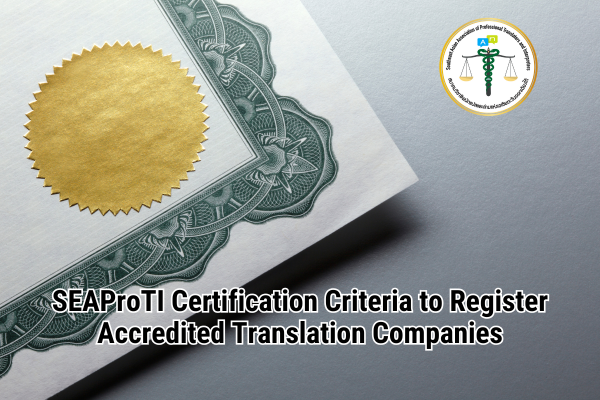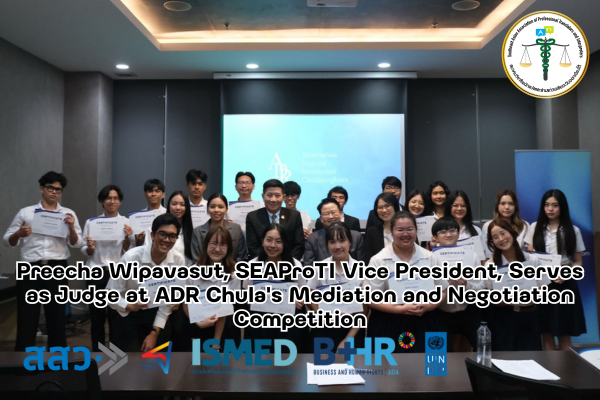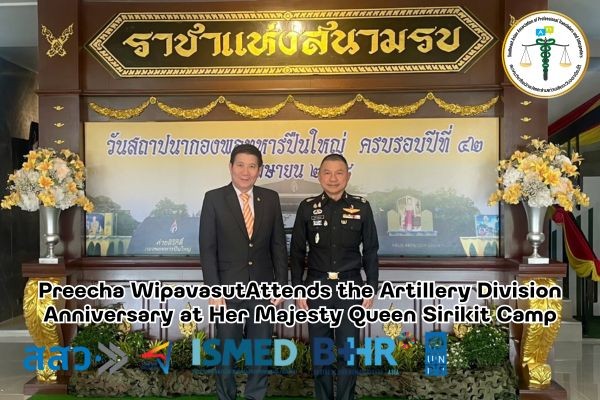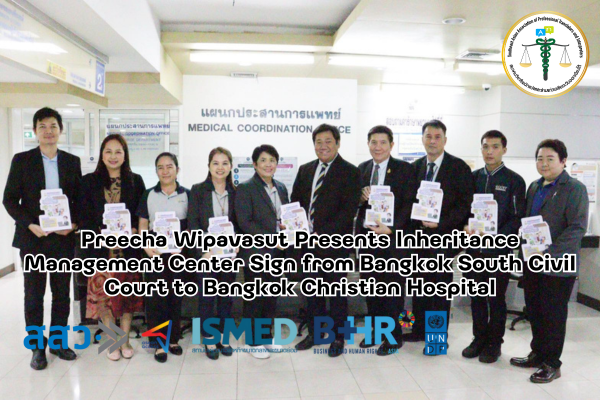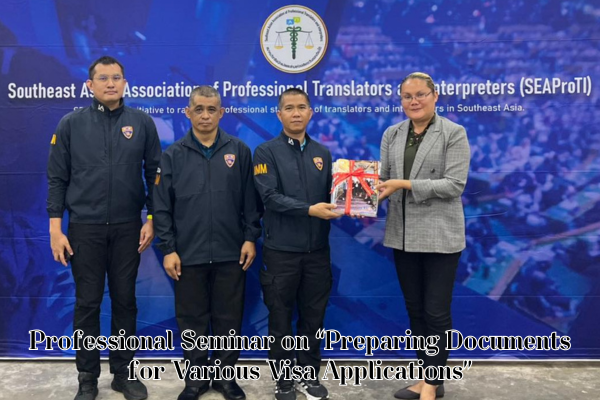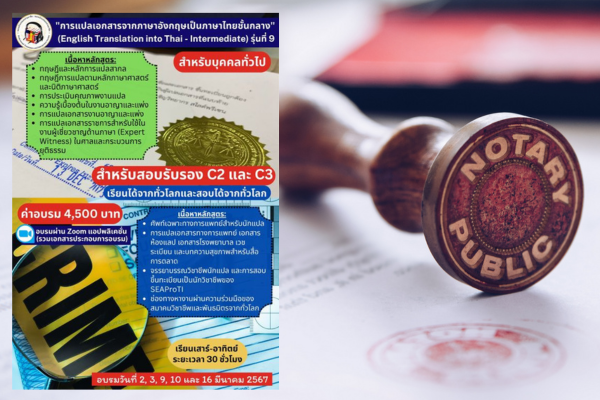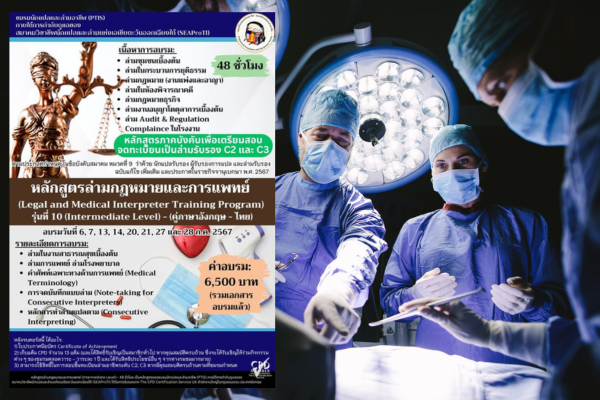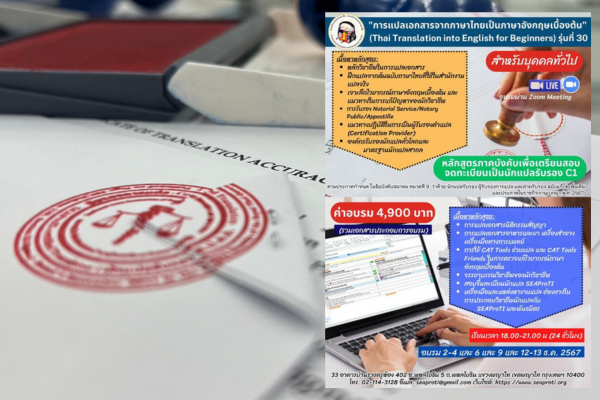Certified Translators, Translation Certification Providers, and Certified Interpreters: Importance and Processes to Know (Section 9 in the Bylaws of the Association)
Document translation and language-related work demand precision, expertise, and deep cultural contextual understanding. Certification of translators plays a critical role in establishing standards and credibility in this profession, especially in cases involving essential documents such as legal, business, educational, or governmental papers, where even minor errors can lead to serious consequences.
In Thailand, the Southeast Asian Association of Professional Translators and Interpreters (SEAProTI) has implemented a systematic process for certifying translators and interpreters to uphold professional standards. One of the key principles adopted by the association is the classification of certified translators into three levels: Certified Translator Level 1 (CT1), Certified Translator Level 2 (CT2), and Certified Translator Level 3 (CT3).
Differences Among the Three Levels of Certified Translators
-
Certified Translator Level 3 (CT3):
Translators at this level are at the starting point of entering the certified translation profession. Applicants must complete a training course organized by the association. This course covers essential content for basic translation, such as text analysis, knowledge of language pairs being translated, and the development of translation skills in various contexts. Upon completing the training, those meeting the requirements can apply for membership in the association as a Level 3 Certified Translator. -
Certified Translator Level 2 (CT2):
At this level, translators are required to demonstrate more advanced expertise, undergoing rigorous evaluation. Applicants must complete in-depth training covering specialized translation content, such as legal systems, standards for translating critical documents, and business-related translations. In addition, they must pass an examination with clear scoring criteria set by the association. This test is designed to assess language skills, analysis, and accuracy in conveying content. -
Certified Translator Level 1 (CT1):
The highest certification level in the association’s system, translators at this level must exhibit outstanding expertise. Applicants are required to have significant experience and advanced knowledge from completing the association’s advanced training programs. In addition to passing a challenging exam with high standards, Level 1 Certified Translators often need to complete translation samples in specialized fields, demonstrating their ability to translate complex documents such as legal contracts, financial reports, and academic articles.
Importance of Not Certifying External Programs
One of SEAProTI’s key policies is not recognizing programs developed or organized by external entities unless they are directly accredited by the association. This ensures the quality of content and training processes aligns with international standards. Programs certified by the association are developed by experts in the field and are continually updated to remain relevant and meet market demands.
Connection Between Translators, Translation Certification Providers, and Certified Interpreters
In addition to certified translators, the association emphasizes the roles of Translation Certification Providers and Certified Interpreters, which are crucial in establishing standards in the language profession. Translation Certification Providers are responsible for reviewing and ensuring the accuracy and completeness of translations before they are used in critical contexts, such as submitting documents to government agencies or legal proceedings. Certified Interpreters, on the other hand, must possess listening and instantaneous message-delivery skills with precision, as well as the ability to perform under high-pressure situations.
Professional Advancement and Benefits
The classification of translators and interpreters into different levels not only helps establish standards but also enables clients to select services that match their needs. For example, highly complex or sensitive work may require a Level 1 Certified Translator with greater expertise and experience. Furthermore, the tiered system allows new translators to develop skills and progress to higher levels with support from the association.
From the client’s perspective, using services from certified translators increases confidence in the quality of the work and reduces risks of errors in the translation process. For translators, obtaining certification not only validates their skills but also opens opportunities for more extensive work, particularly in highly competitive markets.
Conclusion
The establishment of standards in the translation and interpreting profession through SEAProTI’s clear certification system reflects a commitment to the sustainable development of this field. The classification of certified translators into three levels creates transparency and standards aligned with market demands while enhancing credibility and expertise in the profession. Certified Translators, Translation Certification Providers, and Certified Interpreters are vital to advancing the translation industry and facilitating global communication.
SEAProTI’s certified translators, translation certification providers, and certified interpreters:
The Southeast Asian Association of Professional Translators and Interpreters (SEAProTI) has officially announced the criteria and qualifications for individuals to register as “Certified Translators,” “Translation Certification Providers,” and “Certified Interpreters” under the association’s regulations. These guidelines are detailed in Sections 9 and 10 of the Royal Thai Government Gazette, issued by the Secretariat of the Cabinet under the Office of the Prime Minister of the Kingdom of Thailand, dated July 25, 2024, Volume 141, Part 66 Ng, Page 100.
To read the full publication, visit: the Royal Thai Government Gazette
นักแปลรับรอง ผู้รับรองการแปล และล่ามรับรอง: ความสำคัญและกระบวนการที่ควรรู้ (ข้อ 9 ตามข้อบังคับของสมาคม)
18 มกราคม 2568, กรุงเทพมหานคร – การแปลเอกสารและการทำงานด้านภาษาเป็นงานที่ต้องการความแม่นยำ ความเชี่ยวชาญ และความเข้าใจในบริบททางวัฒนธรรมอย่างลึกซึ้ง การรับรองคุณสมบัติของนักแปลจึงมีบทบาทสำคัญอย่างยิ่ง เพื่อสร้างมาตรฐานและความน่าเชื่อถือในสายอาชีพนี้ โดยเฉพาะในกรณีที่เกี่ยวข้องกับเอกสารสำคัญ เช่น เอกสารทางกฎหมาย ธุรกิจ การศึกษา หรือเอกสารราชการ ซึ่งความผิดพลาดเพียงเล็กน้อยอาจนำไปสู่ผลกระทบที่ร้ายแรงได้
ในประเทศไทย สมาคมวิชาชีพนักแปลและล่ามแห่งเอเชียตะวันออกเฉียงใต้ (SEAProTI) ได้กำหนดกระบวนการรับรองนักแปลและล่ามอย่างเป็นระบบเพื่อรับรองมาตรฐานวิชาชีพ หนึ่งในหลักการสำคัญที่สมาคมใช้คือการแบ่งนักแปลรับรองออกเป็นสามระดับ ได้แก่ นักแปลรับรองระดับ ๑ (ปว.๑) นักแปลรับรองระดับ ๒ (ปว.๒) และนักแปลรับรองระดับ ๓ (ปว.๓)
ความแตกต่างระหว่างนักแปลรับรองทั้งสามระดับ
-
นักแปลรับรองระดับ ๓ (ปว.๓): นักแปลในระดับนี้ถือเป็นจุดเริ่มต้นของการเข้าสู่วิชาชีพการแปลที่ได้รับการรับรอง โดยผู้สมัครจะต้องผ่านการอบรมหลักสูตรที่สมาคมรับรองเป็นผู้จัดขึ้น หลักสูตรนี้ครอบคลุมเนื้อหาที่สำคัญสำหรับการแปลเบื้องต้น เช่น การวิเคราะห์ข้อความ ความรู้เกี่ยวกับคู่ภาษาที่แปล และการพัฒนาทักษะการแปลในบริบทต่าง ๆ หลังจากจบการอบรม ผู้สมัครที่ผ่านเกณฑ์จะสามารถสมัครเป็นสมาชิกสมาคมในฐานะนักแปลรับรองระดับ ๓ ได้
-
นักแปลรับรองระดับ ๒ (ปว.๒): ในระดับนี้ ความเชี่ยวชาญของนักแปลจะต้องผ่านการประเมินที่เข้มข้นกว่าเดิม ผู้สมัครต้องผ่านการอบรมที่ครอบคลุมเนื้อหาในเชิงลึก เช่น การแปลเอกสารเฉพาะทาง ความเข้าใจในระบบกฎหมายและมาตรฐานของเอกสารที่ต้องแปล รวมถึงการแปลที่เกี่ยวข้องกับธุรกิจระหว่างประเทศ นอกจากนี้ ผู้สมัครยังต้องผ่านการสอบซึ่งสมาคมกำหนดเกณฑ์คะแนนไว้อย่างชัดเจน การสอบนี้ออกแบบมาเพื่อทดสอบทักษะทั้งในด้านภาษา การวิเคราะห์ และความแม่นยำในการถ่ายทอดเนื้อหา
-
นักแปลรับรองระดับ ๑ (ปว.๑): นักแปลรับรองระดับสูงสุดในระบบของสมาคมต้องแสดงความเชี่ยวชาญในระดับที่โดดเด่น ผู้สมัครในระดับนี้ต้องมีประสบการณ์และความรู้ที่ลึกซึ้งจากการอบรมหลักสูตรขั้นสูงที่สมาคมรับรอง นอกจากการสอบที่ท้าทายและต้องการคะแนนสูงแล้ว นักแปลในระดับนี้มักต้องผ่านการแปลเอกสารตัวอย่างที่เกี่ยวข้องกับหัวข้อเฉพาะทาง เพื่อแสดงให้เห็นถึงความสามารถในการแปลเอกสารที่ซับซ้อน เช่น สัญญากฎหมาย รายงานการเงิน และบทความวิชาการ
ความสำคัญของการไม่รับรองหลักสูตรภายนอก
หนึ่งในข้อกำหนดที่สำคัญของ SEAProTI คือสมาคมจะไม่รับรองหลักสูตรที่พัฒนาหรือจัดขึ้นโดยหน่วยงานภายนอก หากหลักสูตรดังกล่าวไม่ได้รับการรับรองจากสมาคมโดยตรง เนื่องจากสมาคมต้องการควบคุมคุณภาพของเนื้อหาและกระบวนการอบรมเพื่อให้แน่ใจว่าเป็นไปตามมาตรฐานระดับสากล หลักสูตรที่สมาคมรับรองจะถูกพัฒนาขึ้นโดยผู้เชี่ยวชาญในสายวิชาชีพและปรับปรุงอย่างต่อเนื่องเพื่อให้ทันสมัยและสอดคล้องกับความต้องการในตลาดงาน
ความเชื่อมโยงระหว่างนักแปล ผู้รับรองการแปล และล่ามรับรอง
นอกจากนักแปลรับรองแล้ว สมาคมยังให้ความสำคัญกับบทบาทของผู้รับรองการแปล (Translation Certification Providers) และล่ามรับรอง (Certified Interpreters) ซึ่งเป็นส่วนสำคัญของกระบวนการสร้างมาตรฐานในงานด้านภาษา ผู้รับรองการแปลมีหน้าที่ตรวจสอบความถูกต้องและความสมบูรณ์ของการแปล ก่อนนำไปใช้ในบริบทที่สำคัญ เช่น การยื่นเอกสารต่อหน่วยงานของรัฐหรือการใช้ในกระบวนการทางกฎหมาย ขณะที่ล่ามรับรองจะต้องมีทักษะการฟังและถ่ายทอดสารแบบฉับพลันอย่างถูกต้อง รวมถึงความสามารถในการทำงานในสถานการณ์ที่มีความกดดันสูง
การยกระดับวิชาชีพและประโยชน์ที่ได้รับ
การแยกนักแปลและล่ามออกเป็นระดับต่าง ๆ ไม่เพียงแต่ช่วยสร้างมาตรฐาน แต่ยังช่วยให้ผู้ว่าจ้างสามารถเลือกผู้ให้บริการที่เหมาะสมกับความต้องการของตน ตัวอย่างเช่น งานที่มีความซับซ้อนหรือความละเอียดอ่อนสูง อาจต้องการนักแปลรับรองระดับ ๑ ซึ่งมีความเชี่ยวชาญและประสบการณ์มากกว่า นอกจากนี้ การกำหนดระดับยังเปิดโอกาสให้นักแปลมือใหม่ได้พัฒนาทักษะและก้าวสู่ระดับที่สูงขึ้น โดยได้รับการสนับสนุนจากสมาคม
ในมุมมองของผู้ว่าจ้าง การเลือกใช้บริการจากนักแปลที่ได้รับการรับรองช่วยเพิ่มความมั่นใจในคุณภาพของงาน และลดความเสี่ยงที่อาจเกิดขึ้นจากความผิดพลาดในกระบวนการแปล สำหรับนักแปล การได้รับการรับรองไม่เพียงแต่เป็นการยืนยันความสามารถ แต่ยังเปิดโอกาสในการทำงานที่กว้างขึ้น โดยเฉพาะในตลาดที่มีการแข่งขันสูง
บทสรุป
การกำหนดมาตรฐานในสายวิชาชีพการแปลและล่ามผ่านระบบการรับรองที่ชัดเจนของ SEAProTI สะท้อนถึงความมุ่งมั่นในการพัฒนาวิชาชีพนี้อย่างยั่งยืน การแยกระดับนักแปลรับรองออกเป็นสามระดับช่วยสร้างความโปร่งใสและมาตรฐานที่สอดคล้องกับความต้องการของตลาด รวมถึงช่วยเสริมสร้างความน่าเชื่อถือและความเชี่ยวชาญในสายอาชีพ นักแปล ผู้รับรองการแปล และล่ามรับรองจึงเป็นส่วนสำคัญในการพัฒนาวงการแปลภาษาและการสื่อสารในระดับสากล
เกี่ยวกับนักแปลรับรอง ผู้รับรองการแปล และล่ามรับรองของสมาคมวิชาชีพนักแปลและล่ามแห่งเอเชียตะวันออกเฉียงใต้
สมาคมวิชาชีพนักแปลและล่ามแห่งเอเชียตะวันออกเฉียงใต้ (SEAProTI) ได้ประกาศหลักเกณฑ์และคุณสมบัติผู้ที่ขึ้นทะเบียนเป็น “นักแปลรับรอง (Certified Translators) และผู้รับรองการแปล (Translation Certification Providers) และล่ามรับรอง (Certified Interpreters)” ของสมาคม หมวดที่ 9 และหมวดที่ 10 ในราชกิจจานุเบกษา ของสำนักเลขาธิการคณะรัฐมนตรี ในสำนักนายกรัฐมนตรี แห่งราชอาณาจักรไทย ลงวันที่ 25 ก.ค. 2567 เล่มที่ 141 ตอนที่ 66 ง หน้า 100 อ่านฉบับเต็มได้ที่: นักแปลรับรอง ผู้รับรองการแปล และล่ามรับรอง
